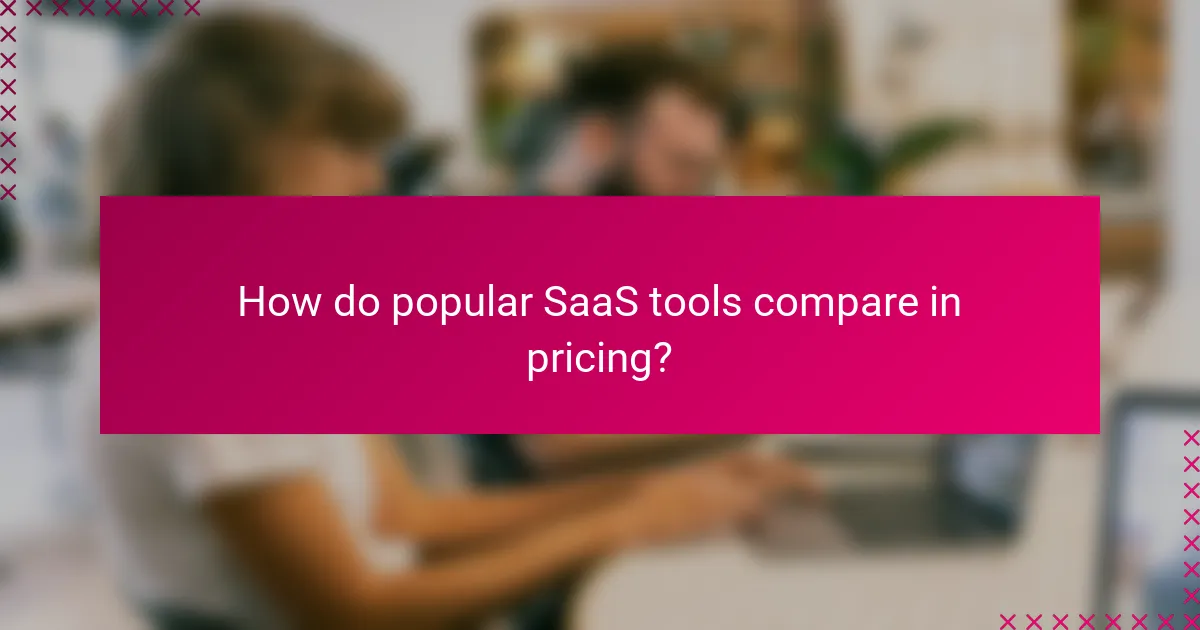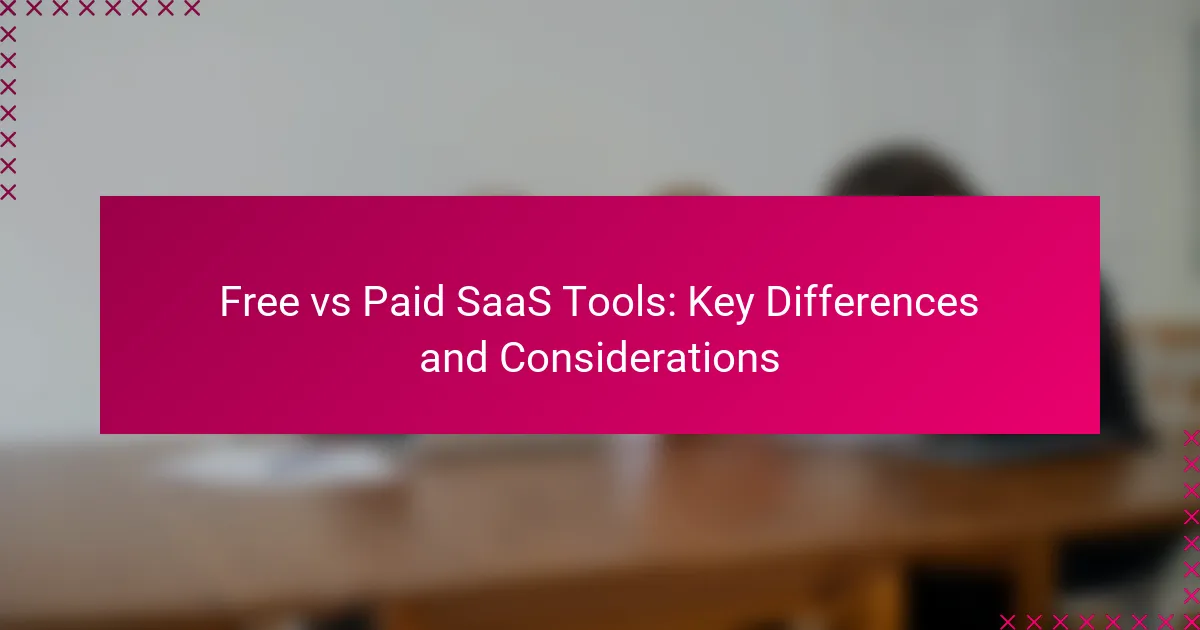When choosing between free and paid SaaS tools, it’s essential to understand the key differences that can affect your experience and productivity. Free tools may provide cost savings and basic functionalities, but they often come with limitations such as restricted features and minimal support. In contrast, paid options typically offer enhanced capabilities, better security, and dedicated customer service, making them a more reliable choice for businesses and serious users.

What are the key differences between free and paid SaaS tools?
Free and paid SaaS tools differ primarily in cost, features, support, data security, and usage limits. While free tools can be appealing for budget-conscious users, they often come with significant trade-offs that can impact functionality and reliability.
Cost structure
The cost structure of free SaaS tools is straightforward: they are available at no charge, making them attractive for individuals or small businesses. However, paid SaaS tools typically involve a subscription model, which can range from monthly to annual payments, often varying from low tens to several hundreds of dollars depending on the service level.
When considering cost, factor in the potential hidden expenses associated with free tools, such as limited features or the need for additional paid services to fill gaps. Weighing the total cost of ownership against your specific needs can help you make an informed decision.
Feature availability
Free SaaS tools often come with a limited set of features, which may restrict their usability for more complex tasks. In contrast, paid tools generally offer a broader array of functionalities, including advanced analytics, integrations, and customization options.
For example, a free project management tool might only allow basic task tracking, while a paid version could include Gantt charts, team collaboration features, and reporting capabilities. Assess your requirements to determine if the features offered by a free tool will meet your needs or if a paid option is necessary.
Support options
Support options for free SaaS tools are usually minimal, often limited to community forums or FAQs. Paid SaaS tools typically provide more robust support, including dedicated customer service, live chat, or even personalized onboarding assistance.
Consider the level of support you might need. If you anticipate requiring frequent assistance or if your team lacks technical expertise, investing in a paid tool with comprehensive support can save time and frustration.
Data security
Data security is a critical consideration when choosing between free and paid SaaS tools. Free tools may not offer the same level of security measures, such as encryption or compliance with regulations like GDPR, which could expose sensitive information to risks.
Paid SaaS providers often invest in higher security standards and protocols, giving users peace of mind regarding data protection. If your business handles sensitive data, prioritize tools that demonstrate strong security practices and compliance with relevant regulations.
Usage limits
Free SaaS tools often impose strict usage limits, such as the number of users, storage capacity, or feature access. These restrictions can hinder scalability and productivity as your needs grow. Paid tools usually offer more generous limits or even unlimited usage options, allowing for greater flexibility.
Before committing to a free tool, evaluate its limitations against your current and future needs. If you expect significant growth or increased usage, opting for a paid solution may be more beneficial in the long run.

What are the benefits of using free SaaS tools in Canada?
Free SaaS tools in Canada offer several advantages, including cost savings and accessibility to essential features. These tools allow users to explore functionalities without financial risk, making them ideal for startups and individuals testing new solutions.
No financial commitment
One of the primary benefits of free SaaS tools is the absence of financial commitment. Users can access software without needing to invest upfront, which is particularly beneficial for small businesses or freelancers with limited budgets. This allows for experimentation with various tools to find the best fit without incurring costs.
However, it’s essential to be aware that some free tools may have limitations or may not provide customer support. Users should evaluate whether the lack of financial commitment aligns with their operational needs and growth plans.
Access to basic features
Free SaaS tools typically provide access to basic features that can meet the needs of many users. These features often include essential functionalities that allow for effective task management, collaboration, or data storage. For example, a free project management tool might offer task assignment and deadline tracking, which can be sufficient for small teams.
While these basic features are useful, users should consider whether they will need advanced functionalities in the future. If so, they may need to plan for potential upgrades to paid versions that offer enhanced capabilities.
Trial for potential upgrades
Using free SaaS tools serves as a trial period for users to assess whether they want to upgrade to a paid version later. This allows individuals and businesses to evaluate the software’s performance and suitability for their needs without any financial risk. If the tool proves beneficial, users can transition to a paid plan that unlocks additional features.
It’s advisable to keep an eye on the upgrade options and pricing structures. Understanding the costs associated with upgrading can help users make informed decisions about whether to continue with the free version or invest in a paid plan that offers more comprehensive support and features.

What are the drawbacks of free SaaS tools?
Free SaaS tools often come with significant limitations that can impact their effectiveness for users. These drawbacks include restricted features, reliance on advertisements, and inadequate customer support, which can hinder productivity and user experience.
Limited functionality
Free SaaS tools typically offer a basic set of features compared to their paid counterparts. Users may find that essential functionalities, such as advanced analytics or integrations with other software, are unavailable or severely limited.
For instance, a free project management tool might only allow a small number of users or projects, making it unsuitable for larger teams or complex tasks. Consider your specific needs and whether the free version can adequately support them before committing.
Ad-supported experience
Many free SaaS tools generate revenue through advertising, which can disrupt the user experience. Frequent ads may distract users and slow down the application, leading to frustration and decreased productivity.
In some cases, ads can also compromise data privacy, as user information may be collected for targeted advertising. Weigh the trade-off between cost savings and potential interruptions when choosing a free tool.
Less reliable support
Free SaaS tools often provide limited customer support, which can be a significant drawback when issues arise. Users may have to rely on community forums or self-help resources, which may not always offer timely or effective solutions.
In contrast, paid services usually include dedicated support channels, such as live chat or phone assistance, ensuring that users can quickly resolve problems. If you anticipate needing support, consider whether the lack of assistance with a free tool could hinder your operations.

When should you choose paid SaaS tools?
Paid SaaS tools are ideal when your business requires advanced features, reliable support, and scalability. Investing in these tools can enhance productivity and provide a competitive edge, particularly as your organization grows.
Business growth needs
As your business expands, you may encounter limitations with free SaaS tools that can hinder your operations. Paid options typically offer more robust functionalities, allowing for better integration with existing systems and accommodating increased user demands.
Consider your growth trajectory and whether your current tools can scale accordingly. If you anticipate significant growth, investing in a paid solution can prevent disruptions and ensure seamless operations.
Advanced feature requirements
Paid SaaS tools often come with advanced features that are not available in free versions. These may include enhanced analytics, automation capabilities, and customizations tailored to your specific business needs.
Evaluate the features you require for your operations. If your projects demand sophisticated tools, a paid option may be necessary to achieve your goals efficiently.
Enhanced customer support
Paid SaaS tools generally provide superior customer support compared to free alternatives. This can include dedicated account managers, priority response times, and comprehensive training resources.
When choosing a SaaS tool, consider the level of support you might need. If your team requires ongoing assistance or quick resolutions to issues, opting for a paid service can save time and reduce frustration.

What factors should you consider when selecting a SaaS tool?
When selecting a SaaS tool, consider your budget, specific use cases, and integration capabilities. These factors will help you determine which solution best meets your needs while providing value for your investment.
Budget constraints
Budget constraints play a crucial role in choosing between free and paid SaaS tools. Free tools often come with limitations in features, support, or usage, while paid options typically offer more robust functionality and customer service. Assess your financial capacity and weigh the potential return on investment.
For example, if your organization has a limited budget, a free tool may suffice for basic tasks. However, if you require advanced features or scalability, investing in a paid solution could be more beneficial in the long run.
Specific use cases
Identifying specific use cases is essential when selecting a SaaS tool. Different tools cater to various functions, such as project management, customer relationship management, or accounting. Ensure the tool you choose aligns with your particular needs to maximize efficiency.
For instance, a free project management tool might be adequate for small teams with straightforward tasks, but larger organizations or those with complex projects may need a paid tool that offers advanced features like resource allocation and reporting.
Integration capabilities
Integration capabilities are vital for ensuring that your SaaS tool works seamlessly with other software and systems you use. A tool that integrates well can enhance productivity by streamlining workflows and reducing manual data entry.
When evaluating tools, check for compatibility with your existing systems and the availability of APIs or third-party integrations. A paid tool may offer better integration options compared to free alternatives, which can be a significant factor in your decision-making process.

How do popular SaaS tools compare in pricing?
Popular SaaS tools vary significantly in pricing, often offering both free and paid plans. Free versions typically have limited features, while paid subscriptions provide enhanced functionalities and support, making it essential to evaluate your needs before choosing.
Slack vs. Microsoft Teams
Slack and Microsoft Teams are two leading collaboration tools, each with distinct pricing structures. Slack offers a free tier with basic messaging features, while its paid plans range from around $6.67 to $12.50 per user per month, depending on the features required. Microsoft Teams is included with Microsoft 365 subscriptions, which start at approximately $5 per user per month, making it cost-effective for organizations already using Microsoft products.
When considering Slack, users benefit from its extensive integrations and user-friendly interface. However, the free version limits message history and app integrations, which may hinder larger teams. Microsoft Teams, on the other hand, excels in video conferencing and collaboration, especially for businesses already embedded in the Microsoft ecosystem.
For teams evaluating these tools, consider the following: if your organization relies heavily on Microsoft products, Teams may be the better choice. Conversely, if you prioritize integrations and a more open platform, Slack could be more suitable. Always assess the specific needs of your team to avoid paying for unnecessary features.
